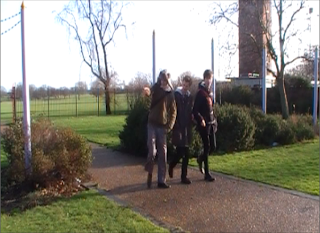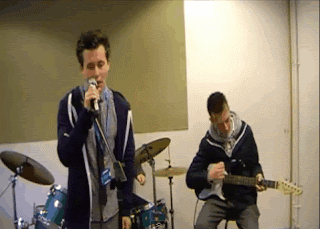It is firstly different to real media conventions in the sense that our artist isn’t idolised – real music videos often contain a heavy use of materialistic mise en scene, with features such as expensive cars, lots of female/male attention (dependent on the artist), idealistic locations, parties, and so on, and teenagers (our target audience) will often find themselves wanting to lead a similar lifestyle and be able to have such things, and will therefore idolise the artist and aspire to be like them. Our video, however, sees the artist in a state of nostalgia and depression (as shown in the differing mise en scene – a picture, dull clothes, etc.) reflecting on his past life which was good, but his present one isn’t so great. Teenagers will not want to be like him because they won’t want to find themselves in his negative position, and that is the pivotal point of our video that makes it differ massively to real music videos. However, despite them not wanting to be in his position, they will still be able to relate to the story and feel his pain, as it were, because it is likely that such a situation could possibly arise in their own personal lives. Therefore, they will relate to/communicate with our artist in such a way that will make them want to watch the video and take an interest in it.

Above: These images show the difference in the previously mentioned things. The first two are are of materialistic/idealistic things that are presented to teenagers in music videos, and things they would want to have - fast cars, lots of attention from the opposite gender, amongst others. The third image is from our video - the only possession our character has is the picture of his ex-lover, which represents reality in a sense, as what they have is minimal as opposed to what they want.
Another key thing to note is the location – as aforementioned, locations used in music videos are typically exotic/out of the ordinary; places in which teenagers would love to find themselves, leading a life of wealth and happiness. However, the location of our video is a park – just an ordinary public park that is used by many people. This is effective in a way because it increases the sense of reality within our video, whereas real media texts make overly materialistic things seem easily reachable, when they are infact unrealistic for their target audience. The use of this location ties in with the previously mentioned relation to the artist – anyone in the world could find themselves in a park (as they are used regularly for both enjoyment, and escaping things you don’t want to face), feeling the way he does, where as only a certain amount of people can actually afford to find themselves in the materialistic idealised places that are portrayed in real media texts.

Above: These images show the differences in location. Again, as with the above, the first one represents exotic and desired locations beauty and wealth, which is where teenagers would like to find themselves. The one below - a screenshot from our video - shows the location of a park, and again is a representation of reality as it is a realistic place in which our target audience would potentially find themselves regularly, which therefore adds emphasis on the way in which they can relate to both the artist himself as well as the overall video/narrative.
Again running with the idea of relating to the artist, the character of our video is represented in a light that can be associated with our target audience – he isn’t presented as a poor person with not much to live for, nor is he presented as someone who has loads to live for – he is just an ordinary person finding himself in an ordinary position, which makes our video relatable and approachable for our audience, unlike real music videos.


Above: These two images show the character representation of characters in real media texts, and then our own. The top image shows the band at a live performance, and it is undoubted that the crowd/audience would like to be like them, look up to them, and want to be in their position - so the characters are represented in a light that has them being idolised. Our video, however, as supported by the bottom image, lacks this - the only thing our character has is people mocking him, and the audience wouldn't want to be in his position/idolise him. However, they would still relate to it, as it is a realistic scenario and could occur in their own being.
Another last way in which our text differs to real media ones is the narrative. Although our video does follow them in the way that there is a clear story-line, the narrative is in some parts fragmented, unlike real videos. The reason why we fragmented the video was to momentarily take the viewers away from the main action in order to keep them wanting to resume watching it and find out what happens at the end of the narrative, or the end of the 'story'. The main way in which our narrative is fragmented is with the use of concert footage, as shown in the image below.

Despite the above, we feel that our music video is also similar to real media texts in the way that it uses special effects and has a linear narrative that is easy to follow. However, with the inclusion of the above differences, we feel that it is a unique piece of media text.
Written by Jack.
Another last way in which our text differs to real media ones is the narrative. Although our video does follow them in the way that there is a clear story-line, the narrative is in some parts fragmented, unlike real videos. The reason why we fragmented the video was to momentarily take the viewers away from the main action in order to keep them wanting to resume watching it and find out what happens at the end of the narrative, or the end of the 'story'. The main way in which our narrative is fragmented is with the use of concert footage, as shown in the image below.

Despite the above, we feel that our music video is also similar to real media texts in the way that it uses special effects and has a linear narrative that is easy to follow. However, with the inclusion of the above differences, we feel that it is a unique piece of media text.
Written by Jack.




No comments:
Post a Comment